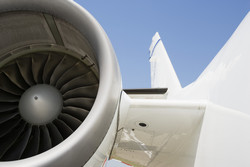Advanced materials for efficient jet engines
The aviation industry is increasingly looking to geared turbofan engines for more efficient flight. Innovative materials with optimised mechanical and physical properties will result in major cuts in fuel consumptions and harmful emissions. Geared turbofan engines may induce very high temperatures in some areas of the turbine and the engine casing and mount. The EU-funded project HITNIFO (Development of an advanced design and production process of high temperature Ni-based alloy forgings) was initiated to produce high-performance materials at low cost by improving processes and thereby overcoming issues related to poor forging and welding possibilities. Project partners selected promising materials for the casing and mount based on nickel alloys for use in high temperatures. Firstly, they conducted annealing trials to investigate changes in microstructure properties due to time and temperature. The trials were also used to identify the main impact on mechanical properties such as yield strength, elongation and stress rupture. After designing and simulating the closed die forging process and producing dies, project partners evaluated the impact of the process on the forging microstructure and mechanical properties. Other activities included flow stress measurements at seven different temperatures and two different strain rates, and measurement of heat capacity and thermal conductivity. Results provided the basis for finite element simulations of material residual stress. In particular, project partners performed simulations with different mesh densities to estimate the residual stress distributions in components of complex geometry. Simulations were then compared with experimental results. HITNIFO opens the way to developing engines with higher exhaust temperatures and therefore higher efficiencies. Use of the optimised nickel-based alloys should see a decrease in the engine and therefore aircraft weight, and lead to decreased fuel consumption.
Keywords
Jet engines, high temperatures, geared turbofan, alloy forgings, nickel alloys

